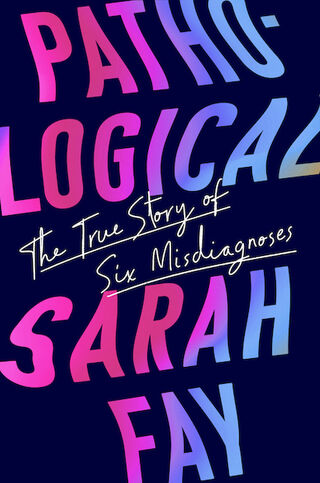DSM
Pathological: The True Story of Six Misdiagnoses
A review of a compelling new memoir on psychiatric error and hubris.
Posted June 16, 2022 Reviewed by Vanessa Lancaster
Key points
- More than 46 percent of American adults and 20 percent of children and adolescents will receive a DSM diagnosis in their lifetime.
- A new memoir draws heavily from the diagnostic manual and its various editions to challenge their reliability and validity.
- The book asks clinicians to pause before assigning powerful diagnostic codes.

Sarah Fay’s memoir of her misdiagnoses joins Elizabeth Wurtzel’s Prozac Nation, Lauren Slater’s Prozac Diary, and Andrew Solomon’s The Noonday Demon in focusing on the raw lived experience of depression and its associated suffering.
“Pathological is everything I wish I’d known,” Fay writes of her 25-year ordeal after a trail of psychiatrists and therapists diagnosed her from age 12 with anorexia, then OCD, then ADHD, followed by generalized anxiety, then major depression, before altering their diagnosis to bipolar disorder.
From there, the battle shifts to whether the correct diagnosis is bipolar I or II, as well as the drug treatments to which she responds best and worst.
Each new diagnosis prompts in Fay, at least, a major rethink of the one preceding it. In her teens and early twenties, she views them as accurate and “real,” even as self-defining: “I believed in and accepted those six diagnoses—adopted them, thought in terms of them, identified myself as them, medicalizing my difficulties and discomforts, pathologizing my emotions and thoughts and behaviors.”
But as the consequences of each misdiagnosis escalate, including to involuntary hospitalization, the book compels us to ask: What do her doctors keep missing? What did each earlier diagnosis overlook? And, most fundamentally, are the treatments contributing to her mounting problems? These evolve from sensations of “cracking” and “splintering” into racing, “belligerent, unrelenting” thoughts; problems with derealization; intense nausea followed by a “brutal Ritalin rebound”; and full-blown bouts of akathisia—agitated distress and restlessness tied to the antipsychotics she is later prescribed, without however experiencing a single psychotic episode.
In each case, the new diagnosis sits precariously atop the previous ones, recasting entire chapters of her life but also raising urgent questions about her psychiatrists’ inter-rater reliability. “What I’d thought was OCD (hypervigilance, obsessive thoughts, social isolation),” she writes, “was ADHD (hyperactivity, overfocus, social isolation).” Just as clearly, so had her psychiatrists before they altered her diagnosis again.
Caught up in each new diagnostic fad, beginning with the “Age of Anorexia” in the 1980s, Fay is one of many patients whose ADHD diagnoses were altered en masse to bipolar disorder a decade later, in a move timed to coincide with the mass-marketing of second-generation antipsychotics: “By then, I was on three [drug treatments]: the SSRI (which I still wasn’t off), a benzodiazepine (for the brain zaps and panic attacks caused by withdrawal), and the anticonvulsant/mood stabilizer lamotrigine. Lithium, the miracle mood stabilizer, would make four.”
The polypharmacy in Fay’s case leads to a cascade of withdrawal problems and cross-effects, though she is told of one switch in a drug regimen in a manner revealing of all: “It’s a simple adjustment. It will be like wearing glasses.”
Removing the “glasses,” though, proves far from easy. Of the drugs’ long-term adverse effects, she is repeatedly advised: “…No, there are no serious risks.” In a follow-up email quoted with permission, Fay confirms: “No one ever suggested we reassess my condition as the circumstances in my life changed and the medication took effect.”
Although the psychiatrists Fay sees are attentive and well-intentioned, seeking always to lessen her suffering, the scale of their repeated errors does not lead to any professional reckoning, much less to even modest introspection over the damage caused. They remain overconfident to a fault, both in the diagnoses they deliver and switch within minutes and in the drug-based treatments they introduce and phase out with similar heedlessness. From various parts of the book:
— He nodded. 'Attention deficit disorder/OCD features with some depressive anxious elements.'
— When our time was up, she sighed. Then she told me I had major depressive disorder.
— Dr. H: 'I would put you in the category of bipolar II.'
— Dr. M: 'Bipolar I with mixed features.'
— Dr. R 'had changed my diagnosis—for the third time.'
“DSM diagnoses are easy to get and aren’t to be trusted,” Fay concludes quite reasonably. As throughout, in a memoir published with an index and 32 pages of references, she backs up the assertion with mountains of evidence, this time from the 2005 National Comorbidity Survey Replication and, more recently, the CDC: “More than 46 percent of American adults and 20 percent of children and adolescents will receive a DSM diagnosis in their lifetimes.”
Over and again, the memoir returns to the troubling question of diagnostic validity, including the post-hoc manner in which “psychiatric medications are used to convince patients that they do indeed have a mental disorder. The medication-as-proof-of-diagnosis theorem is,” Fay remarks, “the diagnostic equivalent of if the shoe fits, wear it.”
Accurate diagnosis can, of course, identify medical conditions and accelerate appropriate treatment. But it can also pathologize behaviors still commonly treated without medication and, in Fay’s case—due to the DSM’s circular logic and power—become self-fulfilling prophecies: “I found evidence for almost every symptom the authors listed….The more evidence I had, the more certain I became. The more certain I became, the more willing I was to undergo treatments.”
“I call them misdiagnoses,” Fay extrapolates the codes and content that fill the influential manual, which still determines whether insurance companies will cover treatment and plays an outsized role in courts, prisons, and schools. “All DSM diagnoses are misdiagnoses—i.e., incorrect, inaccurate, inadequate. They were created by loosening criteria, adding specifiers, shifting symptoms, broadening definitions, and lowering thresholds.”
In a memoir partly devoted to the role of language and punctuation in describing health and illness, Fay’s scrupulous attention to the DSM’s several editions and many textual revisions serves her well. As she remarks on just one of the conditions for which she provides invaluable context, “I learned more about bipolar disorder than any layperson should know.” Leading scholars in the field may be surprised—and some perhaps dismayed—to see their work cited and challenged.
Pathological is similarly astute on related forms of cultural messaging, including how fiction provides other models of mental health and illness. Of Steven Levenkron’s popular 2013 novel about anorexia, Fay writes, “The Best Little Girl in the World offered me a way in [to anorexia] but no way out.” For a while, William Styron’s Darkness Visible: A Memoir of Madness has similar determinative power over her, though it is one she ends up rejecting:
Styron gave me my first understanding of depression. He referred to it as a “mood disorder”—which sounded serious—and defined it as a biochemical malfunction that resulted from “systemic stress” amid “neurotransmitters of the brain” that caused the depletion of serotonin. It sounded so scientific. So reliable. So valid. … In 1990, when Darkness Visible was published, Styron likely would have studied the DSM-III-R.
It’s a striking point: the disease models we inherit involve not just the DSM per se, but the editions it has spawned and the various decades and “eras” they have come to symbolize. Of herself and the psychologist she is seeing at the time, for example, Fay remarks wryly: “Laura and I were in the DSM-III era.”
“Mental illness is very real,” Fay assures me over email; “DSM diagnoses are not. A correct assessment is that I suffered from mental illness for twenty-five years.”
Incisive, insightful, and deeply researched, Pathological urges restraint on DSM-encouraged medicalization and overdiagnosis. It asks clinicians overeager with powerful diagnostic codes to pause before assigning them. It points up the many flaws of a diagnostic manual on which we are over-reliant and endorses the caveats of The Intelligent Clinician’s Guide to the DSM-5 from 2015: “In the absence of independent measures...we cannot be sure that any category in the manual is valid.”




